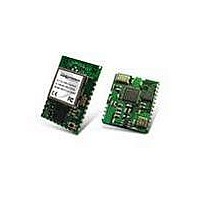WI.232FHSS-250-R Radiotronix, WI.232FHSS-250-R Datasheet - Page 13

WI.232FHSS-250-R
Manufacturer Part Number
WI.232FHSS-250-R
Description
RF Modules & Development Tools 900MHz FHSS Low
Manufacturer
Radiotronix
Datasheet
1.WI.232FHSS-25-FCC-RA-R.pdf
(67 pages)
Specifications of WI.232FHSS-250-R
Lead Free Status / RoHS Status
Lead free / RoHS Compliant
Other names
WI232FHSS-250-R
WI.232FHSS-25-R/ WI.232FHSS-250-R DATASHEET
Initially, the transmission of the packet begins on a random hop index within the current hop sequence, and
follows the hop sequence thereafter until synchronization is lost. Synchronization is lost whenever there is
no more data to transfer and the module has detected two consecutive hop indices without data present.
New data is not sent within the last 5% of the hop sequence, but data which is already in the process of
being sent is processed normally.
The MAC layer prefixes the data with a packet header and appends to the data a 16-bit CRC. The CRC-
16 packet validation can be disabled to allow the application to do its own error checking of the payload.
The Link layer provides three distinct addressing modes: MAC, User, and User Extended. Each of these
addressing modes can be configured to utilize assured (acknowledged) or best-effort (not acknowledged)
delivery. MAC addressing mode is best suited for point-to-point or broadcast transmissions. User and
User Extended modes, with their address masks, allow for the creation of subnets.
The Wi.232FHSS is very flexible because of its extensive configuration options. However, modules that
are not configured in the same way will not be able to communicate reliably, causing poor performance or
outright failure of the wireless link. All modules in a network must have compatible configurations to
ensure interoperability.
In TRANSMIT mode, the transceiver has a complete packet queued for transmission. The module uses
the same CSMA mechanism to arbitrate access to the channel. Once the module gains access to the
channel, the packet is transmitted on the current channel without delay. If BIT_ACK of
regNETMODE
is
set, the module starts TO_ACKWAIT and begins waiting for an ACK from the other side. If the ACK is not
received, a transmission retry is attempted. If the number of transmission retries exceeds
REG_MAXTXRETRY, an exception (EX_NORFACK) is raised.
Once the packet is sent, the transmitter will deactivate, but remain tuned to the current channel until its hop
time has expired. If another packet is queued for transmission, the module will transmit this packet once
the CSMA mechanism allows access to the channel. Once the hop timer has expired, the module will then
hop to the next channel (both transmit and receive channels). The module will remain synchronized until it
dwells for one full hop time without transmitting or receiving a packet. The module will then return to scan
mode.
Certain features of the module are controlled through programmable registers. Registers are accessed by
bringing CMD low. When CMD is low, all data transfers from the host UART are considered to be register
access commands. When CMD is high, all data transfers from the host UART are considered to be raw
data that needs to be transparently transmitted across the wireless link. The module maintains two copies
of each register: one in flash and one in RAM. On reset, the module loads the RAM registers from the
values in the flash registers. The module is operated out of the RAM registers. Applications that need to
change parameters of the module often would simply modify the RAM registers. By putting default settings
in the flash registers, the module will always power up in a preconfigured state, which is useful for
applications that do not have external microcontrollers, such as RS-232 adapters.
The FHSS module has 32 channels spaced on 750 KHz boundaries with guard bands on either side.
These channels are pseudo-randomly arranged into six unique hopping tables comprised of 26 channels.
The order of these tables is chosen so that cross-correlation is minimized, allowing multiple networks to
operate in proximity with minimal interference.
2.2. Operating States
The primary active state is the RX SCAN state. When the module is not actively transmitting or receiving
packets, it is in this state. It is cycling from one channel to another throughout the hop sequence looking
for a synchronizing packet. If the module detects a pre-amble, it will stall the next hop to wait for the start-
code and packet header. If the packet is addressed to it, the module will process the packet and present it
12
Revision 1.1.0













